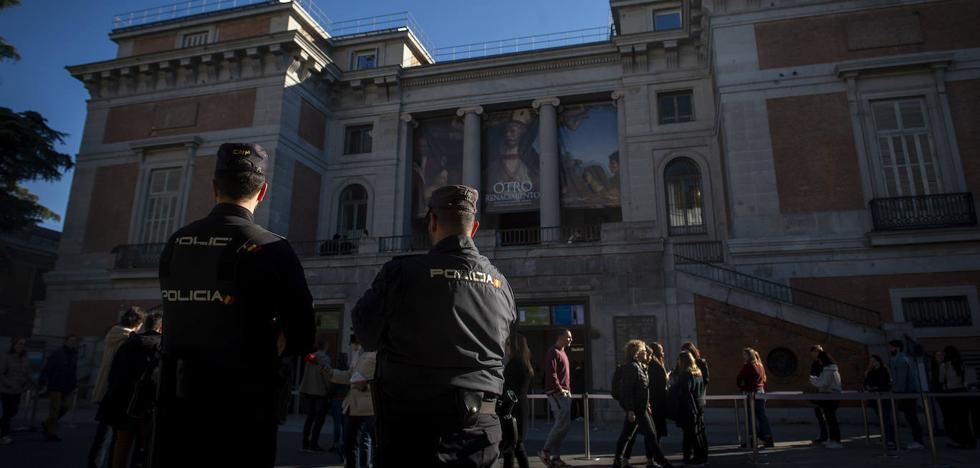The exhibition ‘Landscape, figures and places. From Carlos de Haes to the generation of the 1920s brings together more than forty works by regional and national artists
The Museum of Fine Arts of Murcia, Mubam, hosted yesterday the exhibition ‘Landscape, Figures and Places. From Carlos de Haes to the generation of the 20s. An exhibition consisting of 43 paintings made with different techniques by different artists, both from the region of Murcia and national, which can be visited until February 12. The exhibition aims to “pay tribute to these artists and to the art of landscape as an independent genre,” said Juan García Sandoval, curator of the exhibition together with Elisa Franco Céspedes and director of Mubam.
The common thread of the works is the natural and urban landscape of the Region and other parts of the country, something that each painter personally reflects. “We’re very interested in introducing landscapes with a memory, landscapes that can’t be seen now, they’re being transformed for a variety of reasons and factors,” says Sandoval. Visitors will discover Murcia in the 1920s and 1930s through paintings such as ‘Botanical Garden’ by Antonio Carrión Valverde (1892-1983) of Murcia, which reflects today’s Malecón orchard.
Juan García Sandoval and Elisa Franco Céspedes urge «to value some of the museum’s funds guarded in its rooms. It is a duty to teach it to the citizens.
Elisa Franco believes that the work ‘Country Dancers’, also known as ‘Allegory of Spring’, which opens the journey from romanticism to naturalism and the avant-garde movement, within the Spanish tradition of the generation of the last century of the 1920s, to which this exhibition invites, “is full of optimism, color and joy”. The painting is by Inocencio Medina Vera [primo del poeta Vicente Medina], both from Archena. It was painted for El Casino Moderno de La Unión in 1903 and shows six dancing female figures.
The exhibition bears the name of Carlos de Haes (1826-1898) because he was the ultimate master of 19th-century Spanish landscape architecture and a particularly notable figure in the anthology of 19th-century Spanish art. Several Spanish artists have taken his classes at the Royal Academy of Fine Arts of San Fernando. «He taught with the technique called ‘au plein air’ (in the open air) in French. This type of painter is known as plenaryism, they painted from nature in the open air during study trips all over Spain,” explains Sandoval. The exhibition features four of his works, donated to Mubam a hundred years ago by one of his pupils, the Murcian artist Alejandro Séiquer (1851-1921).
“It’s for the whole family, it’s easy to understand and it shows us a Murcia that has already left,” says curator Elisa Franco. It highlights paintings such as ‘Plaza de Santo Domingo de Murcia with the Cierva Peñafiel Graduate Schools and the demolished Palacio de los Vélez’, by Murcian Antonio Carrión Valverde, where you can see the urban transformations the city has gone through. “It reflects the meeting of streets between the Paseo de Alfonso X el Sabio and the Plaza de Santo Domingo, a priest appears in old costume and hat, and the old convent of Santo Domingo that has already disappeared,” explains Franco.
The exhibition includes a unique ‘Marina’ from the early 20th century by Francisco Portela de la Llera (1869-1950). On the other hand, ‘Casa huertana’ or ‘Higuera en invierno’ by Almela Costa (1900-1989), one of the great landscape artists of the Murcia region, takes us to Murcia in the 1920s, reflected in the shadow of the fig tree in a house. “He knew how to handle light and shadow very well,” says Sandoval.
‘Night Scene by the Sea’ (1858), by Antonio de La Torre, “magnificently conveys a sense of the sublime, of the Romantic era,” says the curator. There is a generation of early 20th century painters who opposed realism, a remarkable change in Murcian painting that was renewed by the influences of English painters such as Wyndham Tryon, who settled in Murcia in 1914 and set up his own painting studio had. Marquis de Corvera.
The five paintings by Juan Bonafé (1875-1940) also occupy a prominent place: landscapes of the Reguerón channel, ‘A las orillas del Reguerón’. The 43 works also include two watercolors by Ramón Gaya (1910-2005) and three oil paintings by Pedro Flores (1897-1967).
Source: La Verdad
I am David Jackson, a highly experienced professional in the news industry. I have been working as an author at Today Times Live for over 10 years, and specialize in covering the entertainment section. My expertise lies in writing engaging stories that capture readers’ attention and deliver timely information about the latest developments.



